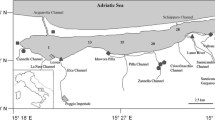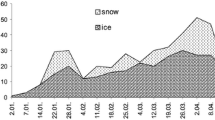Abstract
Nutrients
The inflow of Rhine water into the Oosterschelde was strongly reduced from 1987 onwards. This caused the winter concentrations of silicate and nitrate to decrease in the Eastern compartment, while those in the deeper Western compartment, more dependent on North Sea concentrations, hardly changed. The result was a levelling of the former East-West gradients for these nutrients. In East, summer concentrations of nitrate reached limiting levels in the post-barrier period and molar nitrate/ammonium ratios became < 1, indicating that any release of nitrogen must be important to stimulate phytoplankton growth in this area. Silicate summer concentrations in East, on the other hand, were higher in the new situation. In West, differences in summer nutrient concentrations between the old and new situation were smaller than in East, due to the still continuing exchange with the North Sea.
Phytoplankton diatoms and flagellates
In East during summer, N-depletion and longer residence times caused the phytoplankton to become strongly dependent on nutrient regeneration processes and increased zooplankton grazing. Average diatom biomass declined, but flagellate biomass rose during summer. Spring conditions for phytoplankton development in this area improved due to the increased water transparency, nutrients being present in excess, and this resulted in a higher ‘new’ production of diatoms than before.
In West, summer biomass of diatoms decreased, probably due to increased consumption by mussels under conditions of longer residence times; nutrients were not limiting, due to important benthic mineralization processes and exchange with the North Sea. The previously existing West-East biomass gradients disappeared, or sometimes reversed.
Experimental (mesocosm studies) as well as field data, reported in the literature, give evidence for the given explanations.
Similar content being viewed by others
References
Bakker, C., 1967. Veranderingen in milieu en plankton van het Oosterscheldegebied. Vakbl. v. Biologen 47: 181–192.
Bakker, C. & I. de Vries, 1984. Phytoplankton- and nutrient dynamics in saline Lake Grevelingen (SW Netherlands) under different hydrodynamical conditions in 1978–1980. Neth. J. Sea Res. 18: 191–220.
Bakker, C., P. M. J. Herman & M. Vink, 1990. Changes in seasonal succession of phytoplankton induced by the storm-surge barrier in the Oosterschelde (SW-Netherlands). J. Plankton Res. 12: 947–972.
Bakker, C., P. M. J. Herman & M. Vink, 1994. A new trend in the development of the phytoplankton in the Oosterschelde (SW Netherlands) during and after the construction of a storm-surge barrier. Hydrobiologia 282/283: 79–100.
Bakker, C. & P. van Rijswijk, 1994. Zooplankton biomass in the Oosterschelde (SW Netherlands) before, during and after the construction of a storm-surge barrier. Hydrobiologia 282/283: 127–143.
Boynton, W. R., W. M. Kemp & C. G. Osborne, 1980. Nutrient fluxes across the sediment-water interface in the turbid zone of a coastal plain estuary. In: V. S. Kennedy (ed): Estuarine perspectives. Academic Press, New York: 93–109.
Brzezinsky, M. A., 1985. The Si:C:N ratio of marine diatoms: interspecific variability and the effect of some environmental variables. J. Phycol. 21: 347–357.
Coosen, J., F. Twisk, M. W. M. van der Tol, R. H. D. Lambeck, M. R. van Stralen & P. M. Meire, 1994. Variability in stock assessment of cockles (Cerastoderma edule L.) in the Oosterschelde (in 1980–1990), in relation to environmental factors. Hydrobiologia 282/283: 381–395.
De Jong, D. J., P. H. Nienhuis & B. J. Kater, 1994. Microphytobenthos in the Oosterschelde estuary (The Netherlands), 1981–1990; consequences of a changed tidal regime. Hydrobiologia 282/283: 183–195.
De Jong, S. A., P. A. G. Hofman, A. J. J. Sandee & E. J. Wagenvoort, 1990. Primary production of benthic microalgae in the Oosterschelde estuary (SW-Netherlands). Balans nota 43, DIHO-RWS.
De Vries, I. & C. F. Hopstaken, 1984. Nutrient cycling and ecosystem behaviour in a salt-water lake. Neth. J. Sea. Res. 18: 221–245.
Drinkwaard, A. C., 1960. The quality of oysters in relation to environmental conditions in the Oosterschelde in 1958. Ann. Biol. 15: 224–233.
Dronkers, J. & J. T. F. Zimmerman, 1982. Some principles of mixing in tidal lagoons with examples of tidal basins in the Oosterschelde. In: P. Lasserre & H. Postma (eds), Coastal Lagoons. Proc. Int. Symp. Coastal Lagoons, Gauthier-Villars, pp. 460–474.
Harrison, P. J. & D. H. Turpin, 1982. The manipulation of physical, chemical and biological factors to select species from natural phytoplankton communities. In: G. D. Grice & M. R. Reeve (eds), Marine mesocosms, biological and d chemical research in experimental ecosystems: Springer-Verlag, New York/Heidelberg/Berlin: 275–289.
Helder, W., 1974. The cycle of dissolved inorganic nitrogen compounds in the Dutch Wadden Sea. Neth. J. Sea Res. 8: 154–173.
Herman, P. M. J. & H. Scholten, 1990. Can suspension-feeders stabilise estuarine ecosystems? In: M. Barnes & R. N. Gibson (eds): Trophic Relationships in the Marine Environment, Proc. 24th Europ. Mar. Biol. Symp., Aberdeen Univ. Press: 104–116.
Howarth, R. W., 1988. Nutrient limitation of net primary production in marine ecosystems. Ann. Rev. Ecol. Syst. 19: 89–110.
Korringa, P., 1941. Experiments and observations on swarming, pelagic life and settling in the European flat oyster, Ostrea edulis L. Arch. Néerl. Zool. 5: 1–249.
McCarthy, J. J., W. R. Taylor and L. J. Taft, 1977. Nitrogenous nutrition of the plankton in the Chesapeake Bay. 1. Nutrient availability and phytoplankton preferences. Limnol. Oceanogr. 22: 996–1011.
McCarthy, J. J. & J. C. Goldman, 1979. Nitrogenous nutrition of marine phytoplankton in nutrient-depleted waters. Science 203: 670–672.
Nienhuis, P. H. & A. C. Smaal, 1994. The Oosterschelde estuary, a case study of a changing ecosytmem: an introduction. Hydrobiologia 282/283: 1–14.
Nixon, S., 1981. Remineralization and nutrient cycling in coastal marine ecosystems. In: B. J. Neilson & L. E. Cronin (eds): Estuaries and nutrients, Humana Press, Clifton, New Jersey: 111–138.
Parsons, T. R. & M. Takahashi, 1973. Environmental control of phytoplankton cell size. Limnol. Oceanogr. 18: 511–515.
Parsons, T. R., Y. Maila & C. M. Lalli, 1984. A manual of chemical and biological methods for seawater analysis. Pergamon Press, Oxford Frankfurt.
Prins, T. C. & A. C. Smaal, 1994. The role of the blue mussel Mytilus edulis in the cycling of nutrients in the Oosterschelde estuary (The Netherlands). Hydrobiologia 282/283: 413–429.
Smayda, T. J., 1978. From phytoplankters to biomass. In: A. Sournia (ed.), Phytoplankton Manual. Unesco, Paris, pp. 273–279.
Stortelder, P. B. M., J. S. L. Vink & P. F. Havermans, 1984. Waterkwaliteitskenmerken van de Oosterschelde en Schelde-Rijn Verbinding. RWS-note 83.13.
Tackx, M. L. M., C. Bakker, J. W. Francke & M. Vink, 1989. Size and phytoplankton selection by Oosterschelde zooplankton. Neth. J. Sea Res. 23: 35–43.
Tackx, M. L. M., C. Bakker & P. van Rijswijk, 1990. Zooplankton grazing pressure in the Oosterschelde (The Netherlands). Neth. J. Sea Res. 25: 405–415.
Tackx, M. L. M., P. M. J. Herman, P. Van Rijswijk, M. Vink & C. Bakker, 1994. Plankton size distributions and trophic relations before and after the construction of the stormsurge barrier in the Oosterschelde estuary. Hydrobiologia 282/283: 145–152.
Takahashi, M., D. L. Seibert & W. H. Thomas, 1977. Occasional blooms of phytoplankton during summer in Saanich Inlet, B. C., Canada. Deep-Sea Res. 24: 775–780.
Takahashi, M., I. Koike, K. Iseki, P. K. Bienfang & A. Hattori, 1982. Phytoplankton species' responses to nutrient changes in experimental enclosures and coastal waters. In: G. D. Grice & M. R. Reeve (eds): Marine mesocosms, biological and chemical research in experimental ecosystems. Springer Verlag, New York/Heidelberg/Berlin: 333–340.
Van der Tol, M. & H. Scholten, 1992. Response of the foodweb of the Oosterschelde to a changing environment: functional or adaptive? Neth. J. Sea Res. 30: 175–190.
Van Geldermalsen, L. A., 1985. Evaluation of seasonal nutrient dynamics in the Oosterschelde (SW-Netherlands). Neth. J. Sea Res. 19: 207–216.
Van Stralen, M. R. & R. D. Dijkema, 1994. Mussel culture in a changing environment: the effects of a coastal engineering project on mussel culture (Mytilus edulis L.) in the Oosterschelde (SW Netherlands). Hydrobiologia 282/283: 359–379.
Vegter, F. & P. R. M. De Visscher, 1987. Nutrients and phytoplankton primary production in the marine tidal Oosterschelde estuary (The Netherlands). Hydrobiol. Bull. 21: 149–158.
Vroon, J., 1994. Hydrodynamic characteristics of the Oosterschelde in recent decades. Hydrobiologia 282/283: 17–27.
Wetsteyn, L. P. M. J., J. C. H. Peeters, R. N. M. Duin, F. Vegter & P. R. M. de Visscher, 1990. Phytoplankton primary production and nutrients in the Oosterschelde (The Netherlands) during the pre-barrier period 1980–1984. Hydrobiologia 195: 163–177.
Wetsteyn, L. P. M. J. & C. Bakker, 1991. Abiotic characteristics and phytoplankton primary production in relation to a large-scale coastal engineering project in the Oosterschelde (The Netherlands): a preliminary evaluation. In: M. Elliott & J. P. Ducrotoy (eds). Estuaries and coasts: spatial and temporal inter-comparisons. Proc. ECSA 19 Symp., 1989. Olsen & Olsen, p. 365–373.
Wetsteyn, L. P. M. J. & J. C. Kromkamp, 1994. Turbidity, nutrients and phytoplankton primary production in the Oosterschelde (The Netherlands) before, during and after a large-scale coastal engineering project (1980–1990). Hydrobiologia 282/283: 61–78.
Author information
Authors and Affiliations
Rights and permissions
About this article
Cite this article
Bakker, C., Vink, M. Nutrient concentrations and planktonic diatom-flagellate relations in the Oosterschelde (SW Netherlands) during and after the construction of a storm-surge barrier. Hydrobiologia 282, 101–116 (1994). https://doi.org/10.1007/BF00024624
Issue Date:
DOI: https://doi.org/10.1007/BF00024624




